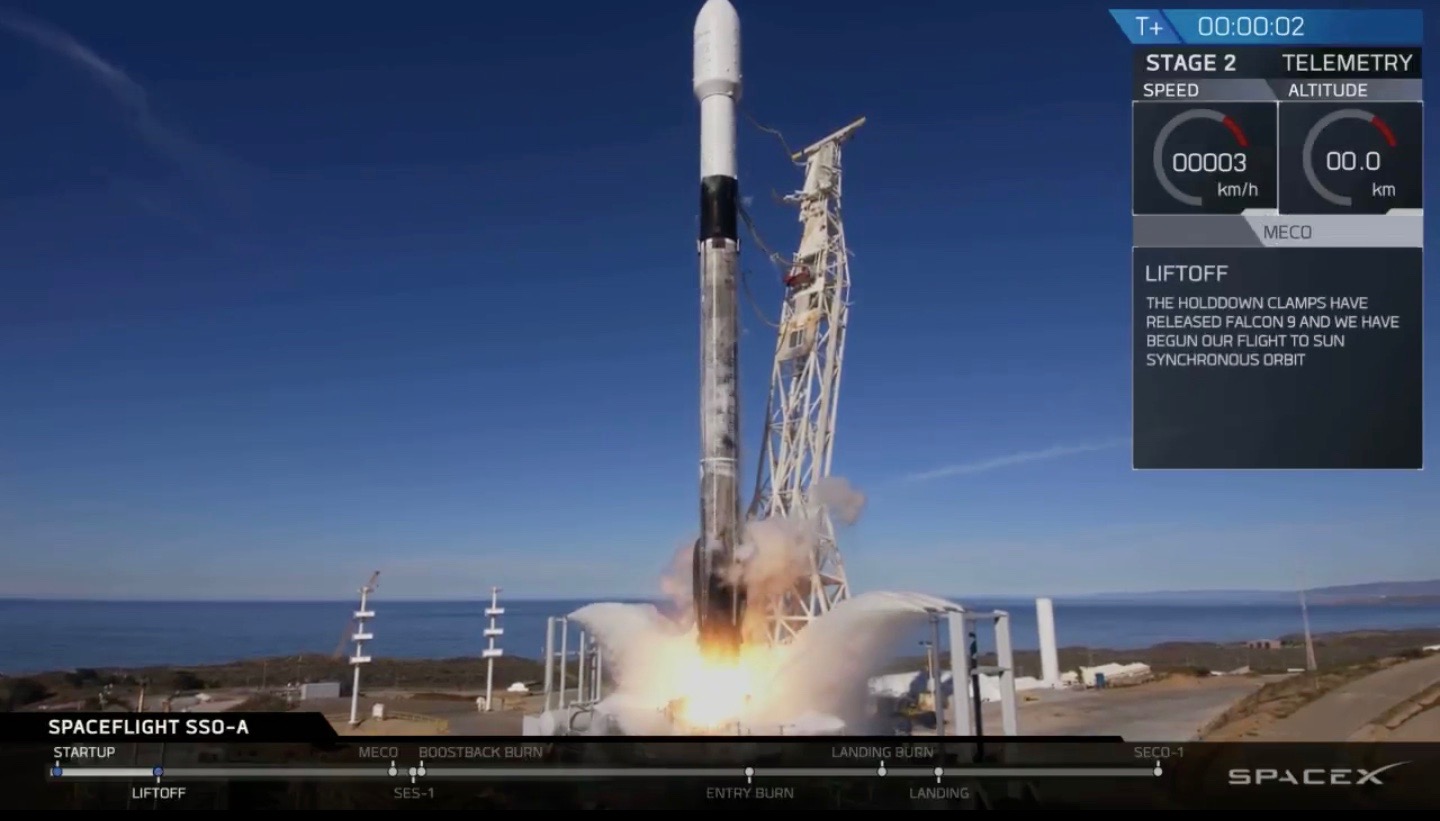A Falcon 9 rocket with a twice-flown first stage lifted off from California's Vandenberg Air Force Base today (Dec. 3) at 1:31 p.m. EST (1831 GMT; 10:31 a.m. local California time), carrying 64 tiny satellites to orbit.
SpaceX has re-flown used first stages many times, but today's launch marked the first time a booster had ever propelled payloads to orbit on three separate occasions. The success is therefore an important milestone for SpaceX, which aims to fly all its vehicles repeatedly and frequently. Such rapid reuse could slash the cost of spaceflight, opening the heavens to exploration, company founder and CEO Elon Musk has said. [Launch Photos: SpaceX Falcon 9 Lofts 64 Satellites (and Lands) on Historic 3rd Flight]
And this particular first stage could conceivably fly yet again. The booster stuck its landing today, touching down softly about 8 minutes after liftoff on the SpaceX drone ship "Just Read the Instructions," which was stationed in the Pacific Ocean.
SpaceX also attempted to catch the rocket's payload fairing — the protective nose cone that surrounds satellites during launch — today with its net-equipped boat, Mr. Steven. (Falcon 9 fairings fall back to Earth in two pieces, each under parachute.) The attempt was unsuccessful, as Mr. Steven's several prior tries have also been. But SpaceX still plans to reuse the fairing, which cost about $6 million to manufacture, Musk said via Twitter today.
"Falcon fairing halves missed the net, but touched down softly in the water. Mr. Steven is picking them up. Plan is to dry them out & launch again. Nothing wrong with a little swim," Musk tweeted.

Today's mission, called "SSO-A: SmallSat Express," set three other records as well, as noted by Florida Today's Emre Kelly. For example, the Falcon 9 first stage became the first booster to lift off from all three currently operational SpaceX orbital launch sites. The first stage helped launched Bangladesh's Bangabandhu Satellite-1 from Pad 39A at NASA's Kennedy Space Center (KSC) this past May, and it lofted the Merah Putih spacecraft from Cape Canaveral Air Force Station in August. (KSC and Cape Canaveral Air Force Station are next-door neighbors on Florida's Space Coast.)
SSO-A, which was organized by the Seattle-based company Spaceflight, was also SpaceX's 19th successful orbital launch of 2018. The company's previous high for a single year was 18, set last year.
Sign up for the Live Science daily newsletter now
Get the world’s most fascinating discoveries delivered straight to your inbox.
And then there are those 64 satellites — the most spacecraft ever launched to orbit atop a single rocket from American soil. (The international record is 104, set in February 2017 by India's Polar Satellite Launch Vehicle, or PSLV.)
If all goes according to plan, all 64 spacecraft will separate from the Falcon 9's second stage less than 45 minutes after today's liftoff (though 60 will still be aboard two Spaceflight "free flyers," from which they will deploy over the next four hours). These new denizens of Earth orbit are a diverse and interesting lot. One of the cubesats, called Enoch, carries a golden "canopic jar" containing a bust of Robert H. Lawrence Jr., the first African-American astronaut. (He never made it to space, dying tragically in a training-flight accident in December 1967 at age 32.)
Then there's another art project, known as Orbital Reflector. The satellite will deploy a shiny, self-inflating sculpture designed to catch the sun and draw skyward the eyes of millions of people down here on Earth. Orbital Reflector is a temporary installation; it will get dragged back into Earth's atmosphere and burn up within a few weeks, project team members have said.
Also aboard is the Elysium Star 2 cubesat, which is owned by the San Francisco-based startup Elysium Space. Elysium Star 2 is carrying the cremated remains of customers who paid (or whose friends or family paid) $2,490 for a "shooting star memorial" — basically, the chance for bits of yourself to be turned into meteors streaking across the sky. If Elysium Star 2 works as planned, it will be Elysium Space's first successful orbital mission.
There are also more "traditional" cubesats, including three more "Dove" Earth-observing craft built by the prolific San Francisco company Planet. Sixteen Doves also launched last week aboard a PSLV, which lofted a total of 31 satellites.
The 64 SSO-A satellites consist of 49 cubesats and 15 "microsats," according to a Spaceflight mission description. More than two dozen of these spacecraft were provided by international organizations, which together involved a total of 17 countries, Spaceflight representatives said.
Many of the payloads were developed by university groups, and a few were even built by high-school teams.
Today's launch had been slated for mid-November, but it was delayed several times so SpaceX could perform additional checks on the rocket, and to wait for high winds over Vandenberg to die down.
This story was updated at 2:55 p.m. EST to include information about Mr. Steven's attempt to capture the Falcon 9's falling payload fairing today.
Mike Wall's book about the search for alien life, "Out There" (Grand Central Publishing, 2018; illustrated by Karl Tate) is out now. Follow him on Twitter @michaeldwall. Follow us @Spacedotcom or Facebook. Originally published on Space.com.











